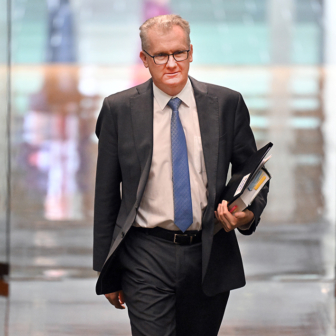In a sense, Rudi Novak’s experiences over the past decade are a common enough tale of people falling in and out of love, of relationships starting and ending, and of children being caught between. Although his story is messier and more complicated, as human lives often are, the problem at its core is a simple one: Rudi’s daughter Maja is Australian, but he is not. And he faces the prospect of having to depart Australia, possibly forever, leaving her behind.
Let’s start at the beginning, or at the least the Australian beginning for Rudi and his first wife, Veronica. (I’m using pseudonyms because Rudi’s situation is delicately balanced.) About ten years ago, Rudi, Veronica and their toddler Maja left Europe for Australia. Veronica was an international student and the primary visa holder. Rudi and Maja were classified as her dependants.
About a year later, Rudi and Veronica’s relationship fell apart. Rudi needed his own visa if he wanted to stay in Australia and remain a father to Maja. He returned to study, starting with an English course then moving on to vocational qualifications in management and IT. At each stage he gained a new student visa.
For reasons that will become apparent, it’s important to stress that Rudi mentioned his daughter whenever he applied for a new visa, and that staying close to Maja was important to him. Technically, such honesty could have cost Rudi dearly, because all international students must satisfy a genuine temporary entrant requirement designed to identify — and potentially exclude — applicants who use the student visa program “for motives other than gaining a quality education.” Personal ties that “present a strong incentive to stay in Australia” are grounds for a refusal.
Rudi’s visas were routinely granted, though, which meant he could study and work during the week and care for Maja at weekends. “It was a good arrangement,” he says, because his relations with Veronica were amicable. “A verbal agreement on shared custody was all we needed.” But that didn’t last.
Over time, Rudi and Veronica both started other relationships. Veronica’s new partner was Australian, and their marriage meant that she and Maja would eventually become Australian citizens. Rudi fell in love with Maria Rosa, an international student from Latin America. Maria and Rudi married and had a baby, Maja’s half-brother Robbie, who is now a toddler.
Somewhere along the way, relations between Rudi and Veronica soured, and they could no longer agree on arrangements for sharing Maja’s care. When months of mediation failed, they ended up in the Family Court. (The involvement of the Family Court is another reason for blurring personal details in this story; Section 121 of the Family Law Act makes it an offence to report on proceedings in a manner that may identify the individuals involved in a particular case.) After a process that lasted eighteen months, the Family Court granted Rudi shared custody of Maja in a roughly 40–60 split with Veronica: Maja spends five nights a fortnight with Rudi, Maria and Robbie during school terms and is with them for half the school holidays.
While the Family Court recognises Rudi’s central role in the life of his daughter, these legally sanctioned shared-custody arrangements have no bearing on his immigration status. So, as Rudi completed his final course and his last student visa neared its end date, he faced a dilemma — how could he stay in Australia and maintain his role as Maja’s father? Although he was steadily employed, he lacked the qualifications that would secure him a visa as a skilled migrant.
As I have reported before in Inside Story, no visa category exists to allow the foreign parent of an Australian child to stay here in order to share his or her care and maintain their relationship. Desperate foreign parents must find complex workarounds, wriggle through migration loopholes, or leave the country and lose access to their child.
Rudi tried two things, and this is where his visa problems got really serious.
One approach involved an application for a contributory parent visa (subclass 143) supported by the church Rudi attends. As the wrinkled faces gracing the relevant pages of the Home Affairs website indicate, this visa is designed for a completely different purpose — to enable adult migrants who have settled in Australia to sponsor their ageing parents to join them here. As Rudi’s child, Maja is eligible to sponsor her father to stay in Australia; as a minor, however, this would require her mother’s consent and signing on her behalf. With the deteriorated relationship between Rudi and Veronica this was not an option, which is why the church stepped in.
This visa category has other drawbacks. It costs around $45,000 per applicant, it presently takes at least four years to process and it can only be granted if the applicant is outside Australia. Unlike many other visas, lodging an application doesn’t make you eligible for a bridging visa — in other words, it doesn’t help Rudi stay in Australia in the short term.
If Rudi, Maria and Robbie were forced to leave Australia until the visa was granted, they would be separated from Rudi’s daughter for four crucial years of her life — years in which she would go from being a teenager to a young adult. “You show love for children by being there,” says Rudi’s migration agent, who is advising him pro-bono. “If you are not present, they feel like they are not loved. When they grow up, they will say, ‘you left me’ and they won’t necessarily understand why.”
“I don’t want to be one of those absent fathers,” says Rudi. Of course, he could maintain a relationship with Maja online, through video calls and messaging apps. But his ability to stay in touch with his daughter would be at the discretion of his former wife. Given their estrangement, Rudi fears that Veronica might not allow such contact. As his migration agent points out, the Family Court’s decision on shared custody doesn’t say anything about the terms of any contact with Maja from overseas. Nor, once he has left Australia, can he go back to the court to seek new orders enabling him to keep in touch with Maja online.
Rudi and Maria also pursued a second option to keep Rudi in Australia. Maria applied for a new student visa, with Rudi and their son Robbie as her dependents. If she were granted a visa, then the family could all live in Australia while she studied, and the contributory parent visa would be much closer to being finalised by the time she completed her course.
But Maria’s visa application was denied. And when she appealed to the Administrative Appeals Tribunal, it was denied there too.
The fly in the ointment was the genuine temporary entrant requirement. Given the family’s extended student visa history in Australia, the presence of an Australian citizen child (Maja) and a lodged contributory parent visa, Home Affairs and the AAT both concluded, quite reasonably, that Maria was not a genuine temporary entrant. A key purpose of her student visa application was to enable Rudi to remain in Australia close to his daughter.
As Rudi’s migration agent acknowledges, Home Affairs and the AAT are not doing anything wrong in a legal sense. They are applying migration law correctly, but the effect of doing so produces a manifest injustice.
Cases like this are not just about rights of foreign parents; they are also about the rights of Australian children. Maja, an Australian citizen, risks being denied a close bond with her father and her younger brother. This contravenes the Convention on the Rights of the Child, which requires signatory states like Australia to ensure “that a child shall not be separated from his or her parents against their will, except when competent authorities… determine, in accordance with applicable law and procedures, that such separation is necessary for the best interests of the child.” In Rudi and Maja’s case, the competent authorities — at the Family Court — have determined exactly the opposite: that it is in Maja’s best interests to have an ongoing relationship with her father.
The convention goes on to say that governments “shall respect the right of the child who is separated from one or both parents to maintain personal relations and direct contact with both parents on a regular basis.” States must deal with a parent’s applications to enter or leave a country for the purpose of family reunification “in a positive, humane and expeditious manner.”
There is nothing positive, humane or expeditious about the operation of Australia’s migration law in such circumstances. The lack of a simple visa pathway forces families to live for years in a state of anxious uncertainty. And in Rudi’s case, that limbo could last a long time yet.
Rudi’s last hope rests with an application for the immigration minister to personally consider his case. The minister has the discretion to replace the tribunal’s decision with one that is “more favourable” if he or she thinks it is “in the public interest to do so.” In short, the minister could choose to grant Rudi and his family visas.
Sometimes referred to as the God powers, ministerial discretion is non-delegable, non-compellable and non-reviewable. In other words, the minister alone makes such decisions; he or she can’t be forced to consider any particular case; there is no set timeline for reaching a decision; and no decision made in this way can be challenged in any court or tribunal.
The process is also entirely opaque. Home Affairs no longer publishes data on requests for intervention, but in the last year it did, back in 2011–12, more than 8000 individual applications were received. It is reasonable to assume the number is higher today. If the minister were to resolve 8000 cases within a year, that would mean working seven days a week and considering and finalising twenty-two applications every day. Of course, the minister doesn’t consider each case personally. Gatekeeping staff vet applications against a set of guidelines to try to identify which ones should progress to the minister’s desk. As the Home Affairs website warns, only a small number do.
So, the fair resolution of exceptional cases like Rudi’s — ones that migration law does not cater for — rely on the discretion of the minister. And yet there is no guarantee the minister will even look at such cases personally.
“We have to work with the legislation we’ve got,” says Rudi’s migration agent. “We’ve been up front and honest all the way.” The agent is buoyed by the fact that Rudi, Maria and Robbie have been granted three-month bridging visas. That suggests that the application didn’t fall at the first hurdle when it was vetted by staff in the minister’s office. But that also means the process could drag on for an unknown period. The responsible minister, David Coleman, has just taken indefinite leave from his portfolio, and his duties have been handed to Alan Tudge. Given the holiday season, and the fact that Mr Tudge will continue as minister for population, cities and urban infrastructure too, it seems unlikely that he’ll get around to considering Rudi’s plight any time soon.
As a result, Rudi and his family could find themselves living on one short-term bridging visa after another, never knowing if it will be renewed, and unable to travel outside the country in the meantime. Rudi worries that if one of his parents back in Europe were to fall seriously ill, he would be unable to visit them.
Rudi knows that sharing his story with me won’t alter his own fate. But he wants Australians to know what is happening to his family, because he thinks the way the law operates is wrong and should be changed.
Cases like his are not common, but as the number of temporary migrants living in Australia continues to grow, more families will be caught up in legal and administrative complexity, trapped between migration law and family law, two systems that don’t talk to one another. For those involved, the stakes are extraordinarily high. Yet it would be relatively easy for the government to create a straightforward visa pathway to enable foreign parents to live in the same country as their Australian children. •




